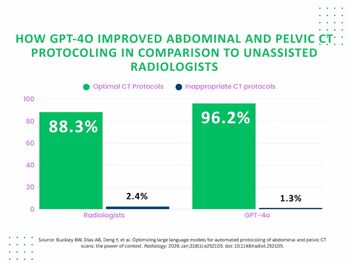
Chest CT Study Shows Benefits of COVID-19 Vaccines in Reducing Incidence and Severity of Related Pneumonia
Patients who had breakthrough COVID-19 infections and full vaccination with the BNT162b2 vaccine (Pfizer/BioNTech) were 36 percent less likely to develop related pneumonia than unvaccinated patients with COVID-19 infections.
A new study looking at chest computed tomography (CT) scans of patients hospitalized for symptomatic COVID-19 infections shows that patients with full vaccination have lower frequency and severity of pneumonia in comparison to unvaccinated patients.
For the retrospective study,
The researchers found that the BNT162b2 vaccine prevented COVID-19 related pneumonia in 51 percent of patients in comparison to 29 percent of those who had the ChAdOx1-S vaccine and 15 percent of unvaccinated patients. In their assessment of semi-quantitative CT severity scores (CT-SS) for patients who developed pneumonia, the study authors noted that unvaccinated patients had a significantly higher mean CT-SS (9.7) in comparison to patients who were fully vaccinated with the BNT162b2 vaccine (5.2) or the ChAdOx1-S vaccine (6.2).
“Pneumonia severity was significantly worse for unvaccinated patients than for patients (who were) fully vaccinated,” wrote Iacopo Carbone, M.D., Ph.D., who is affiliated with the Department of Radiological Sciences, Oncology and Anatomical Pathology at Sapienza University of Rome in Italy, and colleagues. “Vaccination status was significantly associated with pneumonia severity independent of age and sex.”
Seventy-nine percent of the patients who developed pneumonia had bilateral lung involvement, according to the study. Researchers noted bilateral lung involvement in 57 percent of the patients who had the BNT162b2 vaccine, which was significantly lower than those who had the ChAdOx1-S vaccine (90 percent) and unvaccinated patients (86 percent).
“These findings reflect both the importance of considering the specific vaccine type when evaluating vaccine effectiveness, as well as the potential utility of chest CT findings as a source of additional insight when comparing vaccines,” noted Dr. Carbone and colleagues. “Furthermore, radiologists should be aware of the greater frequency of unilateral involvement (an atypical presentation) when interpreting chest CT examinations in patients with BNT162b2 vaccination.”
The study authors did acknowledge a few limitations to their research. In addition to the study being a retrospective design and data coming from a single institution, the researchers noted that they only evaluated two vaccines, which were available in Italy during the study period between mid-December 2021 to mid-February 2022. Carbone and colleagues also noted their assessment focus on initial CT scans precluded examination of longitudinal pulmonary parenchymal changes associated with vaccine use.
Newsletter
Stay at the forefront of radiology with the Diagnostic Imaging newsletter, delivering the latest news, clinical insights, and imaging advancements for today’s radiologists.




























